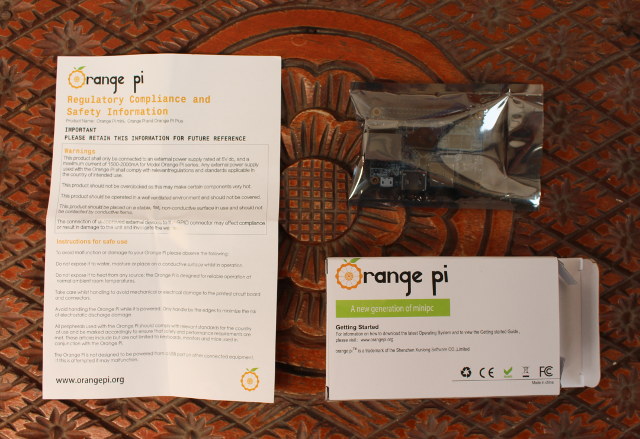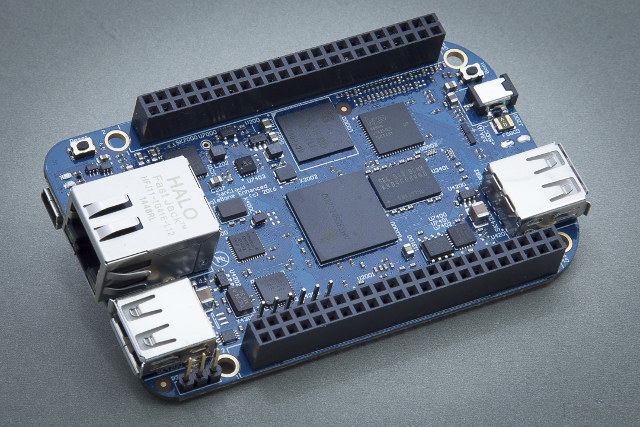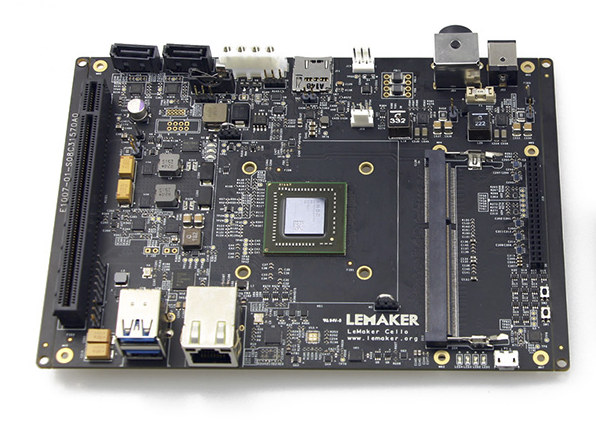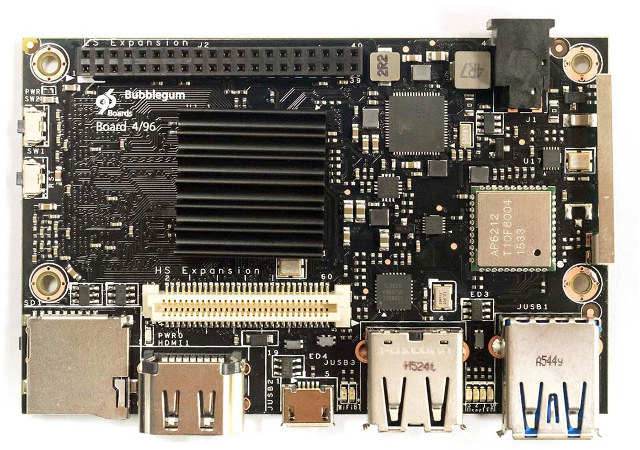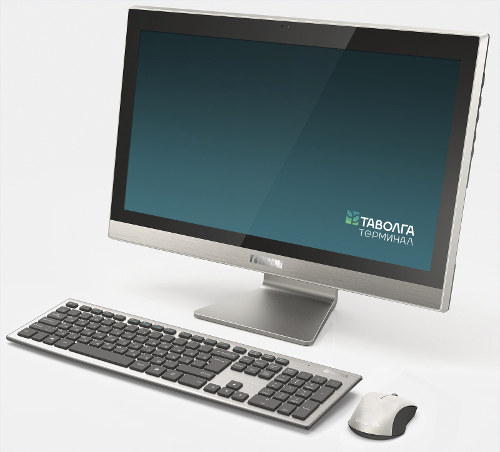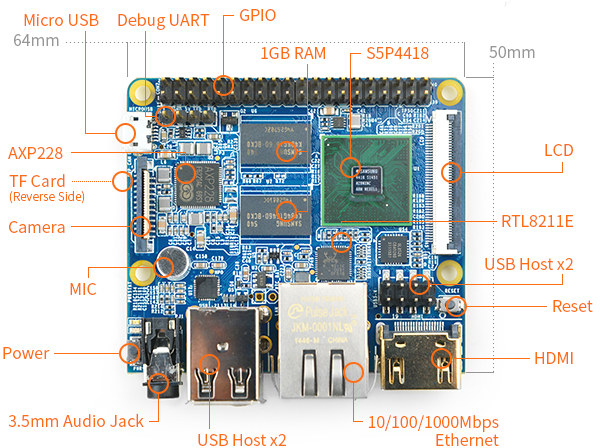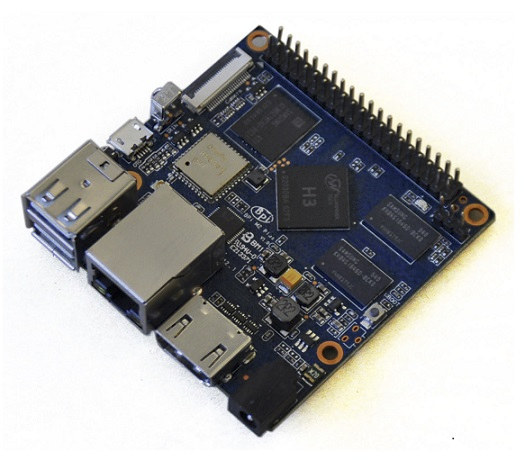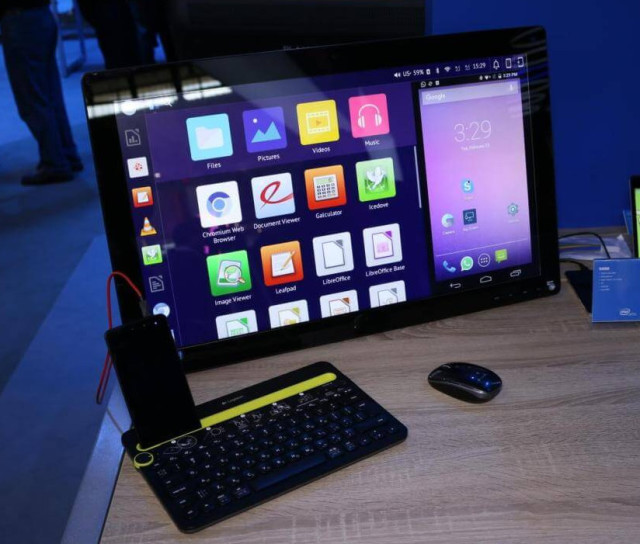Orange Pi One board is the most cost-effective development board available on the market today, so I decided to purchase one sample on Aliexpress to try out the firmware, which has not always been perfect simply because Shenzhen Xunlong focuses on hardware design and manufacturing, and spends little time on software development to keep costs low, so the latter mostly relies on the community. Recently, armbian has become popular operating systems for Linux ARM platform in recent months, so I’ve decided to write a getting started guide for Orange Pi One using a Debian Desktop image released by armbian community. Orange Pi One Unboxing But let’s start by checking out what I received. The Orange Pi One board is kept in an anti-static bag, and comes with a Regulatory Compliance and Safety Information sheet, but no guide, as instead the company simply asks users to visit www.orangepi.org to access information […]
BeagleBone Enhanced Adds Gigabit Ethernet, More Memory & USB Ports, and Sensors (Crowdfunding)
It’s nice to see BeagleBone Black‘s open source hardware being leveraged by third parties, as we’ve already seen designs such as BeagleBone Green and BeagleBone Black Industrial 4G in the past, and now UK based SanCloud has decided to launch BeagleBone Enhanced on Indiegogo (flexible funding). BeagleBone Enhanced board specifications with bold highlights showing improvements over the BeagleBone Black Rev. C: SoC – Texas Instruments Sitara AM3358 Cortex A8 @ 1 GHz + PowerVR SGX530 GPU System Memory – 1GB DDR3 RAM @ 800 MHz Storage – 4GB eMMC flash + micro SD slot, optional 1MB SPI NOR flash USB – 2x USB 2.0 host port (A type), mini USB OTG port, 2x USB interfaces via expansion header Serial Port – UART0 via 3.3V TTL header Ethernet – Gigabit Ethernet Video Output – micro HDMI with EDID support, up to 1280×1024 resolution. Audio Output – Via HDMI Sensors Optional 6 […]
LeMaker Cello 96Boards EE Board Powered by AMD Opteron A1120 Processor Targets Server Applications
There are two versions of Linaro’s 96Boards specifications the Consumer Edition (CE) and the Enterprise Edition (EE) with higher hardware requirements, and while several boards mostly compliant with 96Boards CE are available such as DragonBoard 410c and Hikey boards, the only board announced to be compliant with 96Boards EE specifications was AMD Huskyboard based on Opteron A1100 series processor and is yet to be available for sale. LeMaker has now designed a similar EE boards called Cello. LeMaker Cello board specifications: Processor – AMD Opteron A1120 quad core Cortex A57 processor @ 1.7 GHz with 2MB L2 cache, 8MB L3 cache System Memory – 2x DDR3 SO-DIMM sockets Storage – 2x SATA 3.0 ports, micro SD slot Connectivity – 1x Gigabit Ethernet RJ45 port USB – 2x USB 3.0 ports Expansions x16 PCIe G3 slot 40-pin Low Speed (LE) expansion header Debugging – micro USB port for console access, 10-pin […]
$89 Bubblegum-96 96Boards Development Board is Powered by Actions Semi S900 64-Bit Processor with 2GB RAM
Bubblegum-96 development board was unveiled nearly a year ago, and finally the Actions Semi S900 quad core Cortex A53 board compliant with Linaro’s 96Boards specifications will soon go on sale for $89. Most 96Boards development boards take a while to come to market, likely due to the software requirements. uCRobotics Bubblegum-96 specifications: SoC – Actions Semi S900 quad core Cortex A53 @ up to 1.8 GHz with PowerVR G6230 GPU @ 600 MHz System Memory – 2GB LPDDR3 @ 800 MHz Storage – 8 GB eMMC 4.5 flash + micro SD v3.0 socket Video Output – HDMI 1.4 with HDCP up to 4K, MHL 2.1 up to 4K via USB connector Connectivity – Wi-Fi 802.11 b/g/n, Bluetooth 4.0 USB – 1x USB 2.0 port, 1x USB 3.0 port, 1x micro USB 2.0 port Expansion 40-pin LS (Low Speed) Expansion connector – UART, I2C, 12x GPIOs, SPI, PCM, 1.8V, +5V, GND… […]
Tavolga Terminal TP-T22BT Debian 8 All-in-One Computer is Powered by Baikal-T1 MIPS Processor
A Russian company called Baikal Electronics announced it was working on Baikal T1 dual core MIPS P5600 to provide an alternative to US based Intel and AMD processor last year, not too long after Edwards Snowden revaluations about the NSA malpractices. Good progress has been made as T-Platforms has now launched Tavolga Terminal TP-T22BT All-in-One computer with a 21.5″ display, up to 8 GB RAM, and the Baikal T1 processor running Debian 8. TP-T22BT specifications (derived from product brief in Russian): Processor – Baikal dual core MIPS 5600 processor @ 1.0 GHz with 1MB L2 cache GPU – Silicon Motion SM750 GPU with 16MB video memory, 2D graphics acceleration System Memory – 2 to 8GB DDR3 Storage – Optional 8GB NAND flash, optional 8GB SSD, and optional 2.5″ SATA drive (Baikal-T1 has a built-in SATA interface) Display – 21.5″ IPS Full HD (1920×1080) display with LED backlight Audio – PCM2912A […]
$30 NanoPi-M2 Board Packs Raspberry Pi 2 Hardware Features in a Smaller Form Factor
FriendlyARM had already launched two NanoPi boards powered by Samsung S5P4418 quad core processor, namely NanoPi 2 and NanoPi2 Fire, that were especially interesting due to their small size (75 x 40 mm) for the features including HDMI output, a camera interface, and either WiFi + Bluetooth or Ethernet. The company is now back with a third larger board, but still compact, removing the wireless module, but adding an audio jack and more USB ports, while keeping the price about the same. Meet NanoPi-M2: SoC – Samsung S5P4418 quad core Cortex A9 processor @ 400 MHz to 1.4GHz with Mali GPU including two pixel processors, and a geometry processor. System Memory – 1GB 32-bit DDR3 Storage – 1x Micro SD Slot Connectivity – Gigabit Ethernet RJ45 port (via RTL8211E) Video Output / Display I/F- 1x HDMI 1.4a, 0.5 mm pitch SMT FPC seat for type-A full-color LCD (RGB: 8-8-8) with […]
Banana Pi BPI-M2+ is another Compact Allwinner H3 Development Board
Allwinner H3 processor has become popular on hobbyist boards thanks to several Orange Pi board, especially Orange Pi PC and Orange Pi One due to their ultra-low prices, respectively $15 and $10. Olimex is also involved with their H3-OLinuXino-NANO board, and now at least one more company is about to release another Allwinner H3 board with SinoVoip’s Banana BPI-M2+. Banana BPI-M2 Plus specifications: SoC – Allwinner H3 quad core Cortex A7 @ 1.2 GHz with an ARM Mali-400MP2 GPU up to 600 MHz System Memory – 1GB DDR3 Storage – micro SD card slot up to 64GB, optional 8GB eMMC flash Video & Audio Output – HDMI with CEC support Connectivity – Gigabit Ethernet, optional 802.11 b/g/n WiFi (AP6212). More options: AP6181, AP6335 USB – 2x USB 2.0 host ports, 1x micro USB OTG port Camera – CSI Interface Expansions – 40-pin Raspberry Pi compatible header Debugging – 3-pin UART […]
Intel Showcases Mobile & Desktop “Convergence” with Android and Debian Linux on an Atom x3 Smartphone
MaruOS is an operating system combining Android and Debian Linux that – until recently – was developed by a single developer for Qualcomm Snapdragon 800 (ARM) based Nexus 5 smartphones, and use Android on the go, while switching to Debian when the phone is connected to a larger display and a keyboard and mouse. It turns out Intel had the same idea, and they worked on an Intel Atom x5 smartphone with 2GB RAM running both Android Lollipop in mobile mode, and Debian Linux as desktop mode when connected to a keyboard dock. Intel does not talk about convergence, but instead calls it “Big Screen Experience”. Based on the picture above taken by WinFutures.de at Mobile World Congress 2016, it appears you can also display both Debian and Android operating systems side-by-side if you wish to. They’ve also shot a video (in German) showing the smartphone run Android, and after […]


